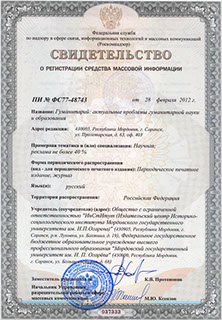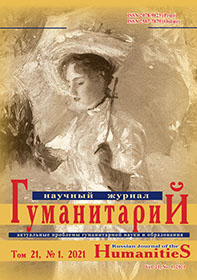ГуманитариЙ актуальные проблемы гуманитарной науки и образования
Russian Journal of the Humanities
ISSN 2078-9823 (Print)
ISSN 2587-7879 (Online)
Navigation
ISSN 2078-9823 (Print), ISSN 2587-7879 (Online)
DOI: 10.15507/2078-9823.053.021.202101.048-062
УДК 37.015
Alexey N. Rukhlin
Ulyanovsk State Pedagogical University named after I. N. Ulyanov (Ulyanovsk, Russia),
e-mail: ruhlenko15@mail.ru
Sects and Religious Movements in the Russian Empire in the Second Half of the XIX – First Quarter of the XX Century оn the Pages of the Simbirsk and Samara Diocesan News
Introduction. The presented article touches upon one of the serious religious problems of Russian history, the phenomenon of “sects”. The author, with the help of the provincial periodical press of the Russian Orthodox Church, tried to highlight the activities of sectarians in the second half of the 19th century until the end of the First World War. The significance of the material presented is undoubtedly, especially in the context of the emergence of new radical sects. To these days, too much depends on the experience of solving this issue, which is acute in our country. The successful resolution of religious problems is the foundation of Russia’s peaceful existence. The purpose of the article is to determine the historical place of sects and sectarianism in the religious life of provinces Middle Volga region, based on the characteristics of their condition and activities, to highlight the policy of the Russian Orthodox Church in relation to sectarians in the period under review, to reveal the special role of the church periodicals aimed at forming environment of negative perception of sects, heretics and all those who broke away from the “true Orthodox teaching”. Materials and Methods. The most important in the study, based on the provisions formulated by the above authors, is the historical method, or, as it is also formulated, the principle of historicism. In carrying out this scientific research, the author relied, first of all, on special historical or general historical methods. Research Results. The study showed that the church media, controlled by local bishops and supported by the secular authorities, carried out an anti-sectarian policy on the pages of their magazines. The Russian Church in Russia had the status of a “state religion” and a monopoly on religious consciousness, therefore it suppressed any deviations from its dogmas. The anti-sectarian tone did not change until 1917. Discussion and Conclusion. We can conclude that the topic of sectarianism is still relevant, moreover, sects continue to arise and develop throughout the world. As long as there are official religions, new sects will be born and spun off. The image of a heretic-sectarian, when necessary, is actively used in propaganda in the media today. The proposed provisions and conclusions create prerequisites for further study of this problem.
Keywords: Russian Orthodox Church, The Simbirsk Diocesan News, The Samara Diocesan News, periodicals, church editors, sect, heretics, Protestants, Shtunda, Old Believers, schismatics.
For citation: Rukhlin A. N. Sects and religious movements in the Russian Empire in the second Half of the XIX – first quarter of the XX century оn the Pages of the Simbirsk and Samara Diocesan news. Gumanitarian : aktual’nye problemy gumanitarnoi nauki i obrazovaniia = Russian Journal of the Humanities. 2021; 21(1): 48–62 (In Russ.). DOI: 10.15507/2078-9823.053.021.202101.048-062.

© Ogarev Mordovia State University. History and Sociology Institute, 2017
68, Of. 411, Bolshevistskaya St., 430005, The editorial office of the scholarly journal «Russian Journal of the Humanities»
Tel.: (8342) 24-25-90; 27-07-11, Fax: (8342) 24-25-90, E-mail: jurnal-econom-hist@isi.mrsu.ru
Designed by A. Napalkov, Email: napalkov@isi.mrsu.ru

